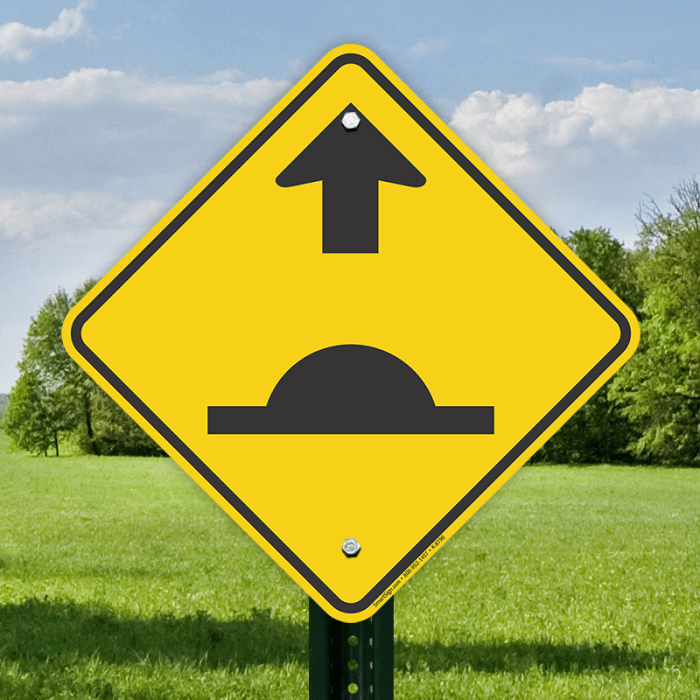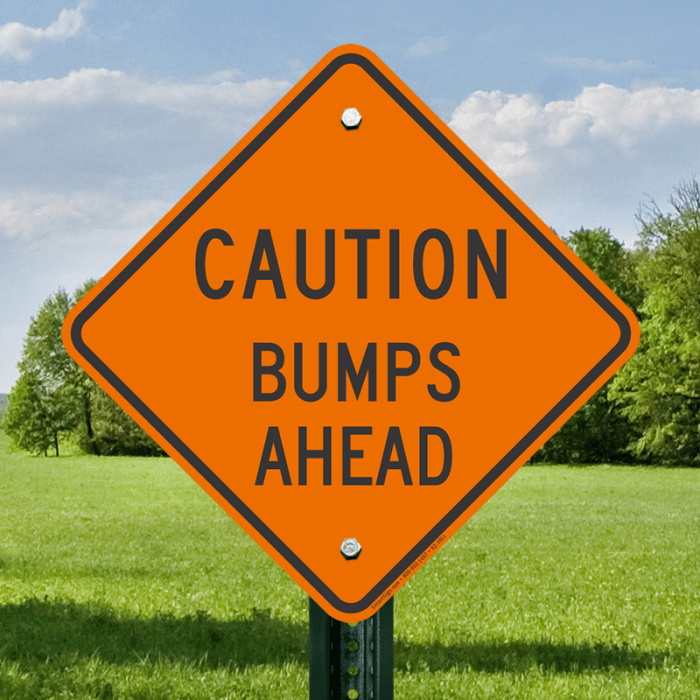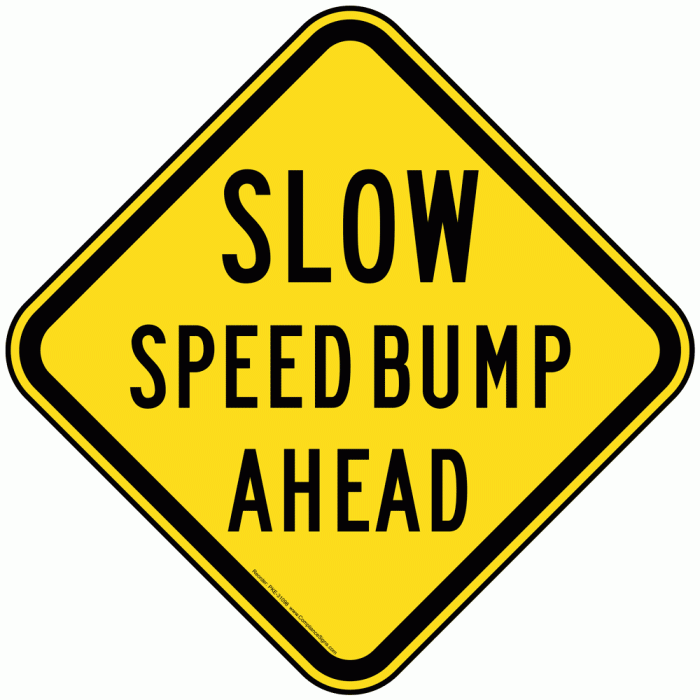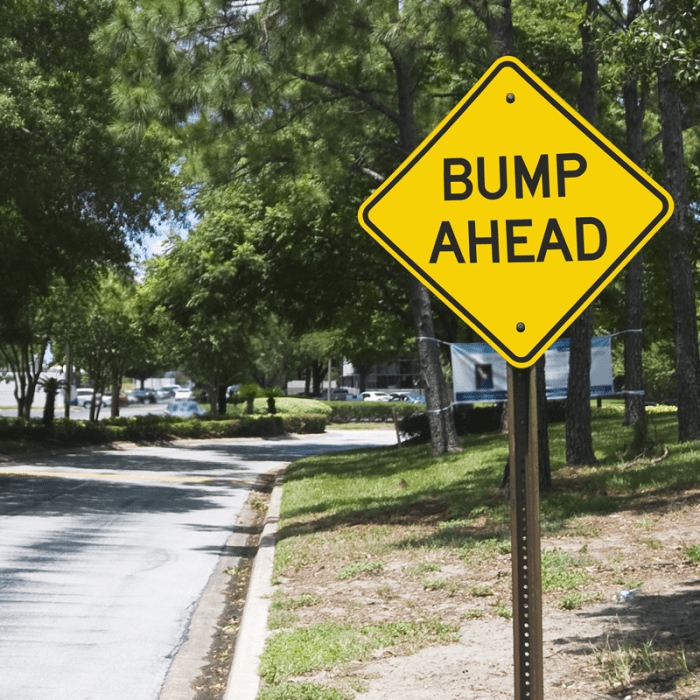Delving into the realm of señal de transito bump que significa, this comprehensive guide unravels the significance of bump signals on our roadways, highlighting their purpose, variations, and crucial role in ensuring road safety. As we embark on this journey, we will explore the visual characteristics, warning nature, and international variations of bump signals, providing an in-depth understanding of their impact on driver behavior and overall road safety.
The content of the second paragraph that provides descriptive and clear information about the topic
Bump Signal Meaning and Purpose
A bump signal is a type of traffic sign that warns drivers of an upcoming bump or uneven road surface. It is typically a yellow sign with a black silhouette of a car driving over a bump. Bump signals are placed in advance of the bump to give drivers time to slow down and avoid damage to their vehicles.
Types of Bump Signals
There are two main types of bump signals:
- Temporary bump signalsare used to warn drivers of temporary bumps, such as those caused by construction or road repairs.
- Permanent bump signalsare used to warn drivers of permanent bumps, such as those caused by railroad crossings or speed bumps.
Examples of Situations Where Bump Signals Are Used
Bump signals are used in a variety of situations, including:
- In advance of railroad crossings
- In advance of speed bumps
- In advance of construction zones
- In advance of road repairs
Visual Characteristics of Bump Signals

Bump signals are distinctive road signs designed to alert drivers of upcoming bumps or uneven road surfaces. They exhibit specific visual characteristics to ensure their visibility and effectiveness in conveying the message.
Typically, bump signals are diamond-shaped with a black border and a yellow background. The shape is universally recognized as a warning sign, and the contrasting colors enhance visibility from a distance. The yellow background signifies caution, urging drivers to reduce speed and proceed with care.
Placement and Visibility
Bump signals are strategically placed on the road to provide ample warning to drivers. They are typically positioned at a suitable distance before the bump, allowing drivers to adjust their speed and driving behavior accordingly. The placement is carefully considered to ensure visibility from both directions of traffic, especially during low-light conditions or inclement weather.
To further enhance visibility, bump signals are often mounted on poles or overhead signs, making them noticeable from a greater distance. This placement ensures that drivers have sufficient time to react and take appropriate action.
Image Reference
[Image of a bump signal with the following description: A diamond-shaped sign with a black border and a yellow background. The image is labeled “Bump Signal”.]
Warning and Advisory Nature of Bump Signals

Bump signals serve as vital warnings to drivers, alerting them to the presence of an upcoming bump or uneven road surface. These signals are strategically placed to provide ample time for drivers to adjust their speed and driving behavior accordingly.
Ignoring or failing to heed bump signals can lead to uncomfortable and potentially hazardous situations.
Importance of Paying Attention to Bump Signals
Paying close attention to bump signals is paramount for ensuring a safe and smooth driving experience. By reducing speed and proceeding with caution, drivers can minimize the impact of the bump, reducing the risk of damage to their vehicles or potential discomfort to passengers.
Moreover, observing bump signals helps maintain a steady and controlled driving pattern, preventing sudden jolts or swerving that could compromise stability.
Accidents and Incidents Related to Ignoring Bump Signals, Señal de transito bump que significa
Statistics indicate that a significant number of accidents and incidents occur due to drivers ignoring or failing to slow down when encountering bump signals. These incidents range from minor bumps and jolts to more severe collisions, highlighting the importance of adhering to these warning signs.
By paying attention to bump signals and adjusting driving behavior accordingly, drivers can significantly reduce the likelihood of being involved in such incidents.
International Variations in Bump Signals

Bump signals exhibit variations in design and meaning across different countries. These variations stem from diverse factors such as cultural influences, historical practices, and road safety regulations.
The following table compares the similarities and differences in bump signals from various regions:
| Region | Shape | Color | Meaning |
|---|---|---|---|
| North America | Rectangular | Yellow | Warning of an upcoming bump |
| Europe | Triangular | Red and white | Advisory sign indicating a bump |
| Asia | Circular | Black and yellow | Warning of a severe bump |
The variations in bump signal designs and meanings can impact road safety. For instance, the triangular shape and red color of European bump signals may be more noticeable and effective in conveying the message of an upcoming bump, leading to increased driver awareness and reduced accidents.
Additional Information and Resources

In addition to the information provided in this article, there are several resources available to help drivers learn more about bump signals and how to drive safely around them.
Relevant Websites and Articles
- Federal Highway Administration (FHWA): Manual on Uniform Traffic Control Devices (MUTCD)
- National Highway Traffic Safety Administration (NHTSA): Driving Safely Around Road Signs
- Insurance Institute for Highway Safety (IIHS): Driving Safety Tips for Road Signs
Tips and Best Practices
Here are some tips and best practices for driving safely around bump signals:
- Slow down when approaching a bump signal.
- Be prepared to adjust your speed and steering to avoid the bump.
- If possible, avoid driving over the bump.
- If you must drive over the bump, do so slowly and carefully.
Use of Technology
Technology can also be used to help drivers identify and navigate bump signals.
- Many GPS devices and mobile apps can provide warnings about upcoming bump signals.
- Some vehicles are equipped with sensors that can detect bumps and adjust the suspension accordingly.
Questions and Answers: Señal De Transito Bump Que Significa
What is the primary purpose of a bump signal?
Bump signals serve as warnings to drivers, alerting them to upcoming road hazards, such as bumps or uneven surfaces, that require reduced speed and increased caution.
What are the different types of bump signals?
Bump signals can vary in design and shape, but they typically feature a triangular or diamond-shaped sign with a black symbol on a yellow background, indicating the presence of a bump ahead.
Why is it important to pay attention to bump signals?
Ignoring bump signals can lead to accidents or incidents, as drivers may fail to slow down and navigate the hazard safely. Paying attention to these signals allows drivers to adjust their speed and driving behavior accordingly, reducing the risk of accidents.